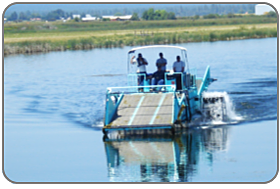How to Get in Touch
After you have browsed our website and models you will undoubtedly have questions. It is always faster and better to connect to an actual person so please contact us in one of three ways:
+ Call us at: 612-868-0143 or via Skype: rkawhc1
+ Send us an email
+ Or complete the contact form and we will get back to you within eight business hours.
Made in the USA

Our Customers

Environmentally Friendly

Aquatic weed harvesting is THE most environmentally friendly solution to remove noxious aquatic vegetation.

